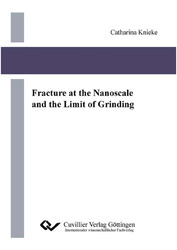| Departments | |
|---|---|
| Book Series (96) |
1378
|
| Nachhaltigkeit |
3
|
| Gesundheitswesen |
1
|
| Humanities |
2364
|
| Natural Sciences |
5406
|
| Mathematics | 229 |
| Informatics | 319 |
| Physics | 980 |
| Chemistry | 1363 |
| Geosciences | 131 |
| Human medicine | 243 |
| Stomatology | 10 |
| Veterinary medicine | 108 |
| Pharmacy | 147 |
| Biology | 835 |
| Biochemistry, molecular biology, gene technology | 121 |
| Biophysics | 25 |
| Domestic and nutritional science | 45 |
| Agricultural science | 1004 |
| Forest science | 201 |
| Horticultural science | 20 |
| Environmental research, ecology and landscape conservation | 148 |
| Engineering |
1793
|
| Common |
98
|
|
Leitlinien Unfallchirurgie
5. Auflage bestellen |
|
Advanced Search
Fracture at the Nanoscale and the Limit of Grinding (English shop)
Catharina Knieke (Author)Preview
Table of Contents, Datei (42 KB)
Extract, Datei (150 KB)
Besides chemical synthesis routes, nanoparticles can be produced in top-down processes nowadays. Stirred media mills are commonly used to break particles down to the nanometer range. Thereby, their stabilization against agglomeration plays a major role to obtain nanoparticle suspensions with the desired properties. Whereas different stabilization methods have been a subject of much research in the last few years, the breakage behavior of nanoparticles is not well understood for the time being. A discrepancy exists between the common state of the art that particles cannot be comminuted below the brittle-to-ductile transition size, which is in the range of a few µm for ceramic particles, and the experimental findings of particles sizes in the nanometer range. In this work, long term grinding experiments of different oxide and non-oxide inorganic materials were carried out to investigate the breakage behavior in the nanometer range. By means of X-ray diffraction analysis and TEM investigations, the evolution of the internal microstructure of the particles was followed during the grinding treatment. A strong correlation between the microstructure and the fracture ability was found. In addition, the existence of a true grinding limit, where no further fracture takes place, and the influence of process and environmental conditions was demonstrated. A physical explanation of the grinding limit originates from changes in the defect structure below a critical crystallite size.
Besides the breakage behavior of brittle ceramics, the grindability of graphite particles as a typical layered material was also investigated. The strong anisotropy of the bond forces in the crystal results in a selective size reduction during the grinding process. By adjusting the process conditions in a way that the acting forces overcome the attractive van der Waals forces between the graphene sheets without breaking them, the production of thinnest flakes with high aspect ratios is allowed. The size reduction was realized as a kind of peeling process. Various analysis techniques such as AFM, Raman spectroscopy, TEM or XPS were employed to characterize the delaminated sheets, especially to determine the exact number of layers. Furthermore, information about the yield of delaminated sheets was given and first examples of application are presented.
| ISBN-13 (Printausgabe) | 3954040859 |
| ISBN-13 (Hard Copy) | 9783954040858 |
| ISBN-13 (eBook) | 9783736940857 |
| Final Book Format | A5 |
| Language | English |
| Page Number | 190 |
| Lamination of Cover | glossy |
| Edition | 1 Aufl. |
| Volume | 0 |
| Publication Place | Göttingen |
| Place of Dissertation | Erlangen-Nürnberg |
| Publication Date | 2012-04-18 |
| General Categorization | Dissertation |
| Departments |
Chemistry
Geosciences Mechanical and process engineering |








